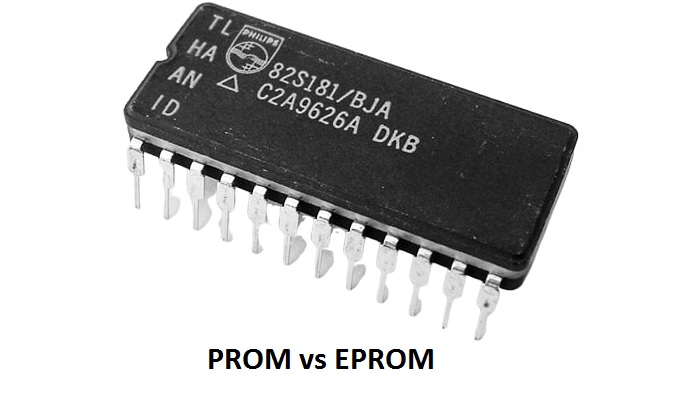The Programmable Read Only Memory or PROM can be programmed only once which means that you can write in it for one time only.
The Erasable Programmable Read Only Memory or EPROM, on the other hand, is erasable. This means that it can be rewritten or reprogrammed.
Well, that is just one aspect of these two types of memories that differentiate each other. However, simply knowing that may not be adequate to make a proper comparison and determine which among them is more useful.
In This Article
KEY TAKEAWAYS
- The PROM chip can be programmed once but the EPROM chip can be reprogrammed several times.
- The cost of PROM is significantly lower in comparison to the cost of an EPROM chip.
- The EPROM is protected from the UV rays with a transparent quartz enclosure but the PROM is encased fully in a plastic cover.
- The storage stability of PROM is not affected by electric current or radiations as opposed to the EPROM.
The 11 Differences Between PROM and EPROM

1. Reusability
The Programmable Read Only Memory chip is not reusable because it cannot be erased, rewritten or reprogrammed. The chip is also rendered unusable if there are any errors, miscalculations or bugs while writing the program on the PROM chip.
On the other hand, the Erasable Programmable Read Only Memory chip is reusable since you can rewrite and reprogram it several times. It can also be used once more if there are errors, bugs, or miscalculations on the chip.
2. The Cost Factor
Typically, the Programmable Read Only Memory chip is a low cost option and is also more cost efficient.
On the other hand, the Erasable Programmable Read Only Memory chip is relatively expensive and is therefore less cost efficient. .
3. Reversibility
In Programmable Read Only Memory the processes are irreversible because the memory is permanent.
On the other hand, for the Erasable Programmable Read Only Memory the processes cannot be reversed.
4. Storage Endurance
In the case of the Programmable Read Only Memory chips the storage endurance is pretty high.
On the other hand, for the Erasable Programmable Read Only Memory chips the storage endurance is less than PROM.
5. Flexibility
The Programmable Read Only Memory chips offer more flexibility.
On the other hand, the Erasable Programmable Read Only Memory chips offer less flexibility.
6. Scalability
The Programmable Read Only Memory chips are more scalable but, on the other hand, the Erasable Programmable Read Only Memory chips are less scalable.
7. Protection
The Programmable Read Only Memory chip is protected by a plastic cowl but, in comparison, the Erasable Programmable Read Only Memory chip is protected by rock crystal windows to protect it from UV rays.
8. Type
The Programmable Read Only Memory is a write-only ROM but the Erasable Programmable Read Only Memory is read and write-type of a ROM.
9. Age
The Programmable Read Only Memory is an older technology.
On the other hand, the Erasable Programmable Read Only Memory is a modern technology.
10. Transistor Used
Bipolar transistors are used to build the Programmable Read Only Memory chips.
On the other hand, a MOS transistor is used to construct the Erasable Programmable Read Only Memory chips.
11. Storage Permanence
The Programmable Read Only Memory chips offer much better storage permanence because it is not affected by electric or radio noise or radiation.
On the other hand, the Erasable Programmable Read Only Memory may be affected by radio or electric noise and radiation and therefore, the storage permanence is affected. However, the chip is capable enough to store data in it for as long as 10 years.
Which is More Useful – PROM or EPROM?

The utility of the two types of memories PROM and EPROM may vary since it will all depend on the needs and preferences of the users.
However, the differences between them as mentioned above may be adequate to make a decision but these additional facts and information may be very helpful for any average user.
Going by the definition of Programmable Read Only Memory, this chip was created with intent to meet the need for a memory that can store a specific type of content in it.
The chip is electrically programmed only once and can be done at the time of fabrication of the original memory chip or by the user if the required content file is provided by the user which is fed into the ROM programmer.
In the PROM chip, there is a fuse at every program connection. When the connection is not required, this connection is blown.
And, according to the definition of EPROM, on the other hand, the Erasable Programmable Read Only Memory chip is optically read and written. The storage cells are in the same initial condition which makes it write associate.
However, you will have lower storage permanency in an EPROM chip as compared to a PROM chip since it is sensitive to electrical and radio noise.
In the EPROM chip Metal Oxide Semiconductors are used as opposed to the bipolar transistors used in the construction of PROM chips.
The PROM chips usually consume more power due to their construction but are quite fast and offer high storage stability.
The bits are not changed until it is reconnected to the ROM programmer and more fuses are blown.
The most significant advantage of the PROM chip is that it offers more convenience and flexibility in comparison to the EPROM chip.
On the other hand, though the EPROM chip can be reprogrammed a thousand times, a single erasure may take as much as 20 minutes to complete.
The MOS transistors in the EPROM chips come with a floating gate which is a tiny piece of poly silicon material.
This is enclosed in an insulator and the channel generates negative charges between the drain and source and stores a logic 1.
At the gate the positive voltage is high which drives negative charges to move out of the channel.
These charges are trapped at the floating gate and store the logic 0.
If the surface of the floating gate is exposed to ultraviolet radiations, it restores the negative charges in the channel from the floating gate as logic 1.
This programming process is called hot electron injection. However, you will have to remove the chip from the system while erasing the data.
And finally, if the above facts are still not enough for you to make out which among the PROM and EPROM chips is more useful, the advantages and disadvantages of each surely would.
One of the most significant advantages of the PROM chip is that you will get a lot of programming tools on the market today and therefore you will not have to bother about hardwiring the memory chip to a program.
However, if there is any error in the data, you will not be able to edit or rewrite the PROM chip.
On the other hand, though an EPROM chip can be rewritten or reprogrammed several times, you will not be able to erase any particular type of byte.
Even if you remove a single byte the entire memory will be removed at once.
Therefore, from the point of view of storage permanence, speed and convenience in use, the PROM chip happens to be more useful than an EPROM.
But if you want a more modern option where you can remove and rewrite programs several times, an EPROM chip would be the best option for you to go for.
Conclusion
Apart from the difference in the cost of the Programmable Read Only Memory and the Erasable Programmable Read Only Memory, as it is clear from the article, there are quite a few other differences amid them.
Now that these are known to you, it should be easy to make a choice among the two memories.